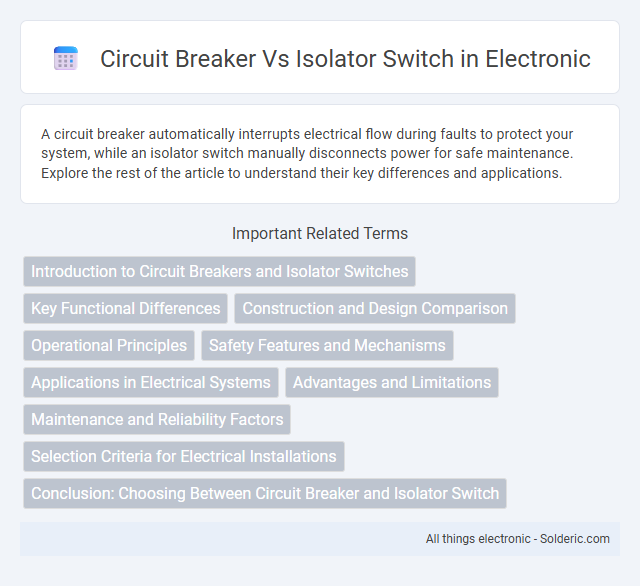A circuit breaker automatically interrupts electrical flow during faults to protect your system, while an isolator switch manually disconnects power for safe maintenance. Explore the rest of the article to understand their key differences and applications.
Comparison Table
| Feature | Circuit Breaker | Isolator Switch |
|---|---|---|
| Purpose | Protects electrical circuit by interrupting current during faults | Isolates electrical circuit for maintenance; does not protect from faults |
| Operation | Automatically trips on overload or short circuit | Manually operated to disconnect circuit |
| Function | Interrupts current flow under fault conditions | Ensures circuit is completely de-energized |
| Safety | Provides safety by breaking current in emergencies | Provides safety for maintenance by isolating circuit |
| Application | Used in all electrical systems for protection | Used mainly for maintenance isolation in high voltage systems |
| Breaking Capacity | Has high breaking capacity to interrupt fault currents | Not designed for breaking current load |
| Types | MCB, MCCB, ELCB | Load break isolator, no-load isolator |
Introduction to Circuit Breakers and Isolator Switches
Circuit breakers protect electrical circuits by automatically interrupting current flow during overloads or short circuits, ensuring safety and preventing damage. Isolator switches provide a manual means to safely disconnect power for maintenance or emergency purposes, without interrupting current automatically. Understanding the distinct functions of these devices helps you maintain electrical systems more effectively.
Key Functional Differences
Circuit breakers automatically interrupt electrical flow during overloads or short circuits, providing essential protection and ensuring system safety. Isolator switches are manually operated devices designed to disconnect electrical circuits for maintenance or repair, without protection against faults or overloads. The primary functional difference lies in circuit breakers offering active fault interruption, whereas isolators serve only as physical disconnection points.
Construction and Design Comparison
Circuit breakers feature an electromechanical mechanism with contacts that automatically trip under overload or short circuit conditions, incorporating arc extinguishing chambers to interrupt fault currents. Isolator switches have a simpler design with manual operation, consisting of exposed or enclosed knife contacts that provide a visible break in the circuit for safety during maintenance. The circuit breaker's complex construction enables automatic protection and resetting capabilities, whereas the isolator's design prioritizes isolation and safety without inherent fault current interruption.
Operational Principles
Circuit breakers operate by automatically detecting electrical faults such as short circuits or overloads and interrupting the current flow to protect the circuit, using mechanisms like electromagnetic or thermal trip units. Isolator switches, on the other hand, function as manual devices designed to safely disconnect a portion of the circuit for maintenance, ensuring no current flows through the isolated section. Your choice between the two should consider that circuit breakers provide automatic protection while isolator switches serve as manual disconnection tools.
Safety Features and Mechanisms
Circuit breakers and isolator switches both enhance electrical safety but through distinct mechanisms; circuit breakers automatically interrupt current flow upon detecting overloads or short circuits, preventing electrical fires and equipment damage. Isolator switches provide a visible break in the circuit, ensuring complete disconnection for maintenance and safeguarding workers from electric shocks. While circuit breakers offer real-time protective response, isolators prioritize manual safety isolation for operational security.
Applications in Electrical Systems
Circuit breakers protect electrical systems by automatically interrupting current flow during faults, making them essential for residential, commercial, and industrial applications to prevent damage and ensure safety. Isolator switches are primarily used for safely disconnecting power during maintenance or repair, often found in distribution panels and substations, enabling technicians to work without risk of electric shock. Your choice between the two depends on whether the primary need is fault protection or safe manual disconnection.
Advantages and Limitations
Circuit breakers provide automatic protection by interrupting electrical flow during faults, minimizing damage and enhancing safety, while isolator switches offer a reliable means to manually disconnect power for maintenance without fault detection capabilities. Circuit breakers are advantageous for their ability to reset after tripping and handle overloads, but they are more complex and costly compared to isolator switches. Isolator switches excel in simplicity, cost-effectiveness, and clear offline indication but lack the automatic fault interruption and protective features inherent to circuit breakers.
Maintenance and Reliability Factors
Circuit breakers require regular testing and inspection to ensure operational reliability and fast fault interruption, minimizing downtime in electrical systems. Isolator switches demand less frequent maintenance since they primarily provide a visible break for safe equipment servicing but do not offer fault protection. Reliability of circuit breakers is critical for system safety, while isolators focus on safe maintenance procedures by ensuring complete disconnection from the power source.
Selection Criteria for Electrical Installations
Selection criteria for circuit breakers versus isolator switches in electrical installations primarily depend on load protection and safety requirements. Circuit breakers are chosen for automatic interruption of fault currents and overload protection, ensuring system reliability and preventing damage. Isolator switches are selected for manually disconnecting circuits during maintenance, emphasizing safe isolation without fault current interruption capabilities.
Conclusion: Choosing Between Circuit Breaker and Isolator Switch
Selecting between a circuit breaker and an isolator switch depends on safety requirements and operational needs. Circuit breakers provide automatic protection by interrupting current during faults, ensuring continuous safety in electrical circuits. Isolator switches are primarily used for manual disconnection and maintenance, offering a visible break but no automatic fault protection.
circuit breaker vs isolator switch Infographic

 solderic.com
solderic.com